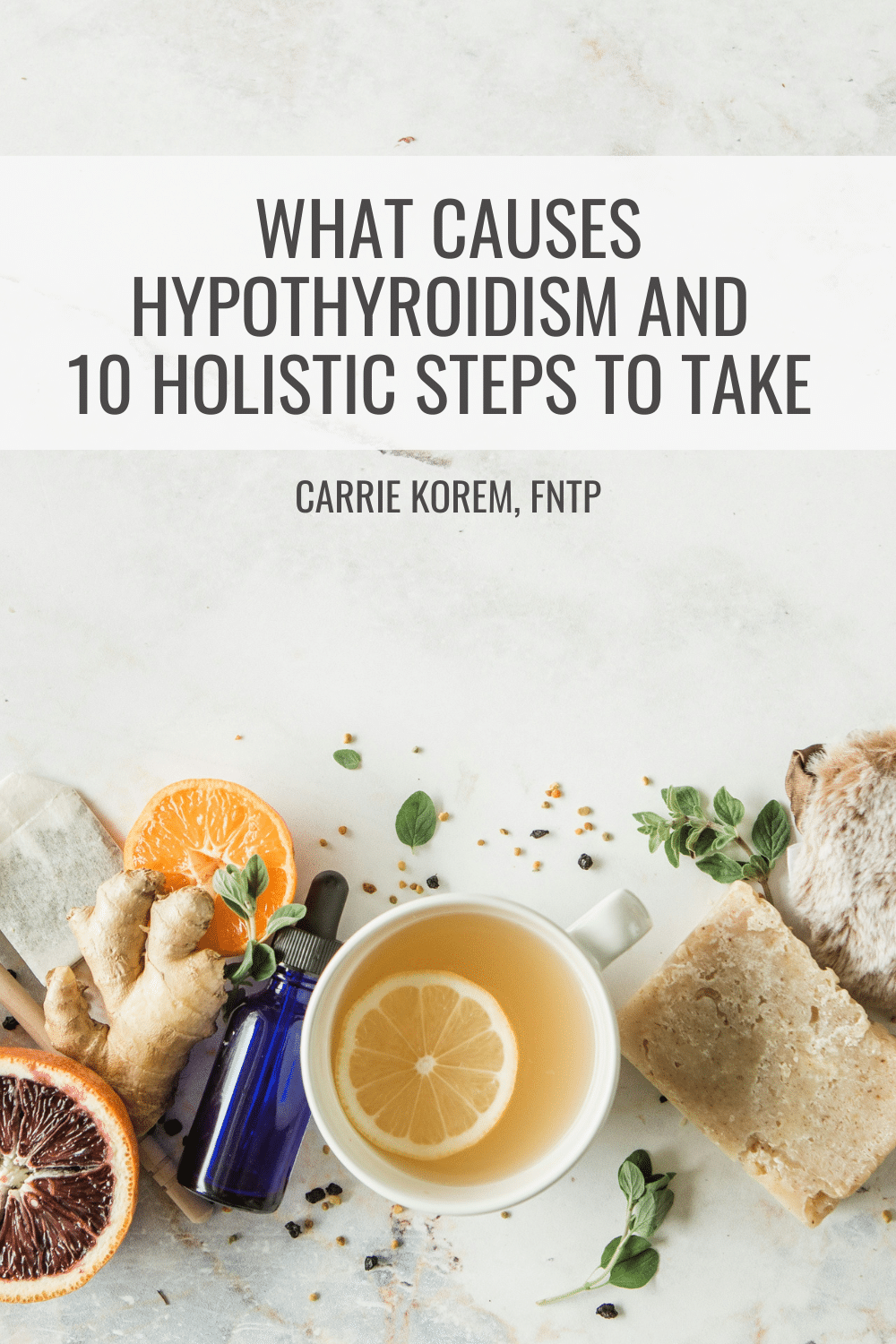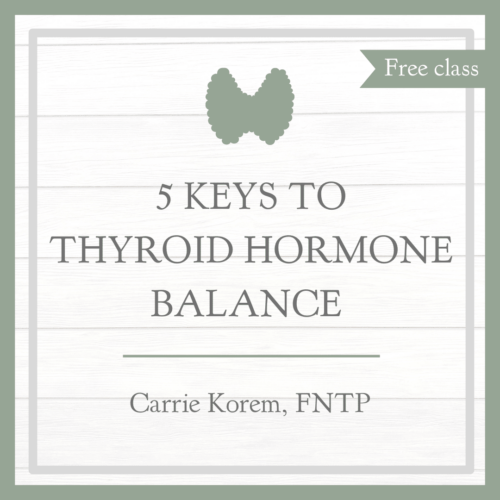When it comes to Hypothyroidism, one of the most important things to understand is that the body never does anything without a reason. If the body is presenting with hypothyroidism, there is always a root cause! Today we’re going to take a look at what causes hypothyroidism and holistic steps you can take to support the thyroid naturally.
What is hypothyroidism?
Hypothyroidism happens when the thyroid gland doesn’t make enough thyroid hormone (ft4 or ft3). This condition also is called underactive thyroid.
It’s important to note that it’s very common for a doctor to diagnose a patient with hypothyroidism when TSH levels are high without actually testing thyroid hormones (ft4 and ft3).
What is TSH and what is an optimal level?
TSH is a hormone that the pituitary sends out to tell the thyroid how much or how little thyroid hormones to produce.
Please note: TSH levels tell you what your pituitary is up to, but it’s not telling you what the thyroid is doing.
Everyone is biochemically individual, but according to functional practitioners, a TSH level between 0.5-2.0 is the range where people feel healthy and vibrant. Most labs have “normal” TSH ranges that span anywhere from 4.0-8.0, but most people with TSH levels this high don’t feel well and need to make some steps to reduce their TSH level.
What is free T4 and what is an optimal level?
Free T4 is a hormone produced by the thyroid. You want free T4 levels to be in the middle of the lab range. So if the range is 1.0-3.0, you want your free T4 to be 2 (or close to it). Each lab has a different range, so you have to look at what the specific range is to know what number to look for.
What is free T3 and what is an optimal level?
Free T3 is a hormone that mostly comes from fT4. The thyroid makes fT4 and sends most of it to the liver to be converted to free T3.
You want free T3 to be in the middle of the lab range. So if the range is 1.0-3.0, you want your free T3 to be 2 or close to it. Each lab has a different range, so you have to look at what the specific range is to know what number to look for.
What causes hypothyroidism?
This really depends on which level is too high or too low, so let’s break this down.
If TSH is elevated:
TSH is a hormone that the pituitary sends out to tell the thyroid how much or how little thyroid hormones to produce.
The pituitary, hypothalamus and adrenals (also called the HPA axis) are all part of the endocrine system and communicate with one another throughout the day. When the body perceives stress – emotional, mental, physical, environmental, mental, stress from disease, etc. – the hypothalamus tells the adrenals to work harder to put out additional cortisol, and it tells the pituitary to produce more TSH so the thyroid will produce less fT4.
So, a high TSH level doesn’t always indicate a thyroid problem. Instead, there’s usually some sort of imbalance in the HPA axis. Your practitioner’s job is to now figure out why there is an imbalance.
Everyone is biochemically individual, but in our practice we’ve found that a TSH level between 0.5-2.0 is the range where people feel healthy and vibrant. Most labs have “normal” TSH ranges that span anywhere from 4.0-8.0, but most people with TSH levels this high don’t feel well and need to make some steps to reduce their TSH level.
One of the biggest drivers of elevated TSH are stressors. So, if your TSH is elevated, regardless of if you also have low or high fT4, you really want to take a good look at the stressors in your life.
Here are some of the stressors and other root causes that can cause elevated TSH:
Emotional stress
Mental stress
Physical stress
Not getting enough sleep
Chronic illness or disease
Living in a cold environment
A move
Surgery
Over exercising
Elevated cortisol
Not eating enough food
Fasting
Low cortisol
Adrenal imbalance
Not eating enough healthy carbohydrates
Dental work
A car accident, death in the family, or any other traumatic event
An issue with the pituitary
Low fT4
A change in your schedule – new job, night shifts, a new baby, etc.
Nutrient deficiencies such as low retinol, zinc, and vitamin D
Certain medications
Common root causes of low fT4:
1. Most often, free T4 is low because the thyroid doesn’t have the resources to produce the proper amount of T4. The thyroid needs iodine and tyrosine to produce thyroid hormones. Increasing the consumption of iodine-rich foods, reducing exposure to chlorine, fluoride and bromine (this is incredibly important!), and taking an iodine supplement can often help improve this imbalance.
If you’re concerned about taking iodine when you have thyroid disease, read this post and it should answer your questions.
2. Free T4 can also be low when thyroid antibody levels such as TPOab or Tgab are elevated. When antibodies attack the thyroid tissues, this can make it difficult for the thyroid to produce enough fT4.
3. Another common cause of low FT4 is anemia. The body needs iron to make TPO, which is then used to make a thyroid hormone (FT4). When the body is deficient in iron, FT4 levels can drop, putting the body in a hypothyroid state. To read more about this, and see what steps you can take to reverse the issue, click here.
4. Having your thyroid removed, radiated or ablated, or being born without a thyroid.
Common reasons of low fT3:
1. Free T3 can be low because there isn’t enough free T4 being produced by the thyroid to be converted into free T3.
2. If there are adequate levels of free T4, but there isn’t enough free T3, then this often indicates liver congestion.
Let me explain. . .
Your thyroid produces T4 and sends most of it to the liver to be converted into the active form, free T3. If you have enough free T4, but not enough free T3, then you don’t necessarily have a thyroid problem, instead, you may need to support your liver so it can efficiently convert T4 to T3 for you.
Liver congestion is pretty common nowadays, and can not only cause low T3 in the body, it also can cause estrogen dominance, severe headaches, blood sugar imbalance, chemical sensitivities, skin issues, and dark circles under the eyes, among other things. Here is an article I wrote with specific steps you can take to improve this issue.
3. Free T3 can also be low because there is excess cortisol (from adrenal imbalance) that is blocking the conversion of free T4 to free T3 and instead creating an excess of reverse T3.
4. Nutrient deficiencies such as zinc, selenium, or vitamin D.
10 steps to take to Support the Thyroid Naturally:
1. Ask your practitioner for a full thyroid panel. Remember, TSH tells you what’s going on with the pituitary, not your thyroid. So, getting a look at what’s actually going on with your thyroid will give you and your practitioner more insight as to what steps to take next.
Here’s the list of labs to ask for (if your practitioner will not order labs for you, you can order them yourself here):
TSH
TPOab
TgAB
Free T3
Free T4
Reverse T3
2. If your free T4 levels are low, then I recommend increasing your consumption of iodine-rich foods (sea vegetables, wild seafood, cultured yogurt, pastured eggs, etc.) and reduce your exposure to chlorine, fluoride and bromine (read this article to find out why this is important).
3. If TSH is elevated, then I recommend taking steps to balance your adrenals and nervous system.
4. If fT3 is low, then taking steps to support gentle liver detox and reducing your cortisol (aka stress) can be helpful.
5. Reduce your sugar intake. Sugar and stress basically do the same thing in the body (minus the calories), so to help balance your TSH and reduce your hypothyroidism symptoms, you need to watch your sugar intake.
If you have sugar cravings right now (I’ve been there before!), make this recipe for buttermints and follow the directions listed.
6. Remember that your practitioner is working for you, not the other way around. It’s ok to ask them questions about the root cause of what’s going on. If they don’t treat you respectfully when you ask them questions about what’s going on with your body, then it’s ok to find another practitioner to work with.
It took me nine months of going doctor-to-doctor before I found someone who would listen to me and run tests. Being persistent to find the right practitioner to work with pays off!
7. Start moving away from processed foods and eat real, nutrient-dense foods. I’ve got hundreds of recipes here on my site and another 125 in my cookbook, The Grain-Free Family Table. Eating healthy foods will reduce the strain on your body and help bring things back into balance.
8. Make sure to get plenty of selenium, zinc, magnesium, iron, healthy saturated fats, Vitamin A (remember retinol/Vitamin A is only found in animal foods), B vitamins, Vitamin C and Vitamin E in your diet as they are all essential for thyroid support.
9. Support digestion so your body can utilize the nutrients in your food. Click here to read some practical steps to take.
10. If you’d like to learn from first steps you can take to help support your thyroid, check out my class, “3 Keys to Thyroid Hormone Balance”. It’s just 45 minutes and I promise you’ll learn something new!



